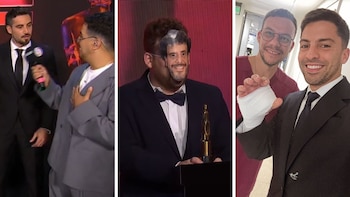
Since the beginning of the coronavirus pandemic, there has been talk about the search to achieve herd immunity through vaccination as a way to control the health emergency. This concept implies that the transmission of an infectious agent such as viruses can be attenuated because a large proportion of the population is already protected through vaccination or by previous infection.
But in the third year of the pandemic, only 66% of the US population accessed the primary vaccination scheme and 30% have the booster, and the Ómicron variant - now with its BA.2 subvariant as predominant - of the coronavirus continues to circulate. In this context, Dr. Anthony Fauci and colleagues from the institute he leads in the United States argue that the Herd immunity should no longer be expected for COVID-19.
In an article published in The Journal of Infectious Diseases, Dr. Fauci, who is the leader of the pandemic response in the United States, along with scientists David Morens and Gregory Folkers, who are part of the National Institute of Infectious Diseases and Allergy, argued their perspective with an analysis of the history of the concept of herd immunity.

“As is commonly understood, herd immunity thresholds are reached when a sufficient proportion of the population is vaccinated or has recovered from a natural infection with a pathogen such that their community circulation is reduced below the level of significant threat to public health,” they said. As an example, they indicated that the threshold for herd immunity has been met with the circulation of polio and measles in the United States.
But experts now consider that the classic concept cannot be applied for the coronavirus pandemic. They argued that “SARS-CoV-2, the virus that causes COVID-19, is so different from polio and measles that classic herd immunity may not be easily applied. Important differences include the phenotypic stability of polio and measles viruses, and their ability to elicit long-term protective immunity, compared to SARS-CoV-2. For these and other reasons, “controlling COVID-19 by increasing herd immunity can be an elusive goal,” they said.
Although they believe that the goal of herd immunity would not be met, Fauci and colleagues expressed optimism in saying that “the widespread use of public health interventions currently available to prevent and control COVID-19 will allow most activities of daily life to resume with a minimum of disturbances”.

The authors explain how scientific understanding of group immunity and its applications to various diseases has evolved over time. High levels of group immunity have allowed the United States to largely control polio and measles, two diseases caused by viruses that have not undergone significant evolution. However, the authors note, the benefits of reaching herd immunity thresholds have been less successful with respiratory viruses such as influenza, which continuously mutate.
Fauci and his colleagues argue that classic herd immunity against the SARS-CoV-2 coronavirus is unlikely to be achieved by a combination of factors that include characteristics of the virus as well as current social dynamics. One of the factors is the ability of the virus to continuously mutate into new variants. Another issue is that the virus spreads and there are people who acquire the infection without showing symptoms and this “complicates public health control strategies”.
They also warn that there is the inability of previous infection or vaccination to provide lasting protection against re-infection.” Added to all these factors are “suboptimal vaccination coverage” in the United States, and the lack of adherence by the population to non-pharmacological interventions, such as wearing a mask or distancing.

However, the authors point out that it is now possible to control COVID-19 without causing major disruption to society, thanks to generalized basic immunity through previous infection or vaccination, booster vaccines, antiviral drugs, monoclonal antibody therapies and widely available diagnostic tests. Research remains crucial to develop pan-coronavirus vaccines, which could protect against multiple coronaviruses or at least multiple variants of the coronavirus.
“The best way to live with COVID is not to reach a numerical threshold of immunity, but to optimize the protection of the population without prohibitive restrictions in our daily lives,” they said. A year ago, on the other hand, the climate was different. Millions of people were queuing up daily to get vaccinated, and it was seen as an opportunity to defeat the virus. But the factors they described changed expectations. It means that “we will not be without the coronavirus in the population for a considerable period of time,” Fauci said.
Like the virus that causes COVID-19, the measles virus spreads through the air. It is so contagious that if a person has it, 9 out of 10 people around them will be infected if they are not immune, according to the CDC. Some experts have estimated that the Ómicron variants of the coronavirus are as contagious as measles. Measles control also raised hope for COVID-19.

In the United States, measles transmission was eliminated and the virus was prevented from circulating in the country thanks to an extremely effective vaccine; a virus that does not change significantly over time; and a successful childhood vaccination campaign. The measles vaccine is 97% effective in preventing the disease. Once a person is vaccinated, studies have found that protection lasts virtually a lifetime.
Between 2010 and 2018, it is estimated that 23 million deaths worldwide were prevented with the measles vaccine alone. Thanks to vaccines, it was possible to eliminate many diseases that represented the main cause of mortality, illness and disability such as measles and polio. America was the first region in the world to be declared free of these diseases thanks to vaccination and the implementation of a quality epidemiological surveillance system. In order to maintain these achievements, it is necessary to maintain the quality standards of surveillance and guarantee vaccination coverage of 95%, although due to the impact of the pandemic they have fallen.
According to Dr. Fauci, “bad news number one is that the coronavirus that causes COVID-19 changes a lot and significantly. “We have already experienced over a period of two years that we have had five separate variants Alpha, Beta, Delta, Omicron. And now the BA.2 of Ómicron,” he said. “The second bad news is that there is no widespread acceptance of safe and effective vaccines,” Fauci said. In short, not enough people have been vaccinated. In the United States, only 77% of the population agreed to receive at least the first dose of the vaccine, and 66% completed the scheme.

Meanwhile, according to Dr. Adam Kucharski, co-director of the Centre for Epidemic Preparedness and Response at the London School of Hygiene and Tropical Medicine, the more contagious the virus, the more people need to be vaccinated to prevent it from wiping out a community. When the Delta variant of COVID-19 was circulating, 98% of the population should have been vaccinated if inoculants could prevent 85% of the virus transmission.
In an article published in the journal Eurosurveillance, Kucharski and his co-authors explained that much herd immunity also depends on the effectiveness of vaccines to prevent transmission. That is, how much does it prevent an already immunized person from infecting another if he acquires the infection.
In the case of measles vaccine creates sterilizing immunity. On the other hand, COVID-19 vaccines do not. While vaccination does reduce the chances that the coronavirus can be transmitted to another person, contact tracing studies have shown that it continues to occur.
If a sufficient number of people are not vaccinated, which has to be practically the entire population because highly contagious subvariants are circulating, or the vaccines we have do not stop almost all transmission, we may not be able to achieve herd immunity to COVID-19 until most people have developed immunity after contracting the infection, Kucharski wrote in the article.
Other factors should also be taken into account, such as the durability of immunity over time. “Not only is vaccine-induced immunity not for life, but immunity induced by infection is not lifelong,” Fauci warned. That means people will need repeated exposures to vaccines or infection to keep their defenses up.

However, some are not willing to give up completely the idea of achieving herd immunity. Barry Bloom, professor emeritus of public health at Harvard University in the United States, considered that one way to achieve this would be to make better vaccines. Companies are working on vaccines that target more stable parts of the virus, including the spike protein stem, which doesn't seem to mutate as much. This could create a longer lasting immunity that could resist the change in shape of the virus variants.
There are also promising vaccines in the form of a nasal spray that could help develop antibodies in the nose and throat. The hope is that these vaccines can generate sterilizing immunity that prevents transmission. And if it's not a vaccine in a nasal spray, says Bloom, why not put monoclonal antibodies in a spray that can be taken daily before leaving home to prevent transmission of the virus? Dr. Bloom believes there is a possibility that the coronavirus will continue to circulate but cause mild symptoms. This is probably what happened with the coronaviruses that now cause common colds.
From Uruguay, virologist Santiago Mirazo, adjunct professor in the Department of Bacteriology and Virology of the Faculty of Medicine of the University of the Republic, told Infobae: “I fully agree with what Dr. Fauci and his colleagues from the United States said. I have long argued that herd immunity cannot be achieved for one simple reason. The percentage of vaccine coverage that confers herd immunity depends on the effectiveness of vaccines in preventing infection and the transmissibility of the pathogen.”
According to Dr. Mirazo, “the effectiveness of vaccines has been greatly reduced since the circulation of the Ómicron variant and transmissibility has increased greatly from the Delta variant and will continue to do so. In this scenario, it is virtually impossible to acquire herd immunity through vaccination. Maybe hybrid immunity could bring us a little closer to it. But with today's vaccination platforms it's virtually impossible. The key could be in a second generation of oral vaccines that mount a type of mucosal immune response that prevents (or significantly limits) infection.”
“Coronavirus is a disease like the flu and not like measles or polio, according to Dr. Fauci. It can change and vaccines do not last long. That's why it makes it difficult for herd immunity to be achieved. In any case, I agree with Fauci that it will be possible to live with the virus with public health measures and new vaccines,” Dr. Lautaro De Vedia, former president of the Argentine Society of Infectology (SADI), told Infobae. “In the future, cases of COVID-19 could continue to appear, but not a pandemic,” he said.
KEEP READING:
Últimas Noticias
Debanhi Escobar: they secured the motel where she was found lifeless in a cistern
Members of the Specialized Prosecutor's Office in Nuevo León secured the Nueva Castilla Motel as part of the investigations into the case

The oldest person in the world died at the age of 119
Kane Tanaka lived in Japan. She was born six months earlier than George Orwell, the same year that the Wright brothers first flew, and Marie Curie became the first woman to win a Nobel Prize

Macabre find in CDMX: they left a body bagged and tied in a taxi
The body was left in the back seats of the car. It was covered with black bags and tied with industrial tape
The eagles of America will face Manchester City in a duel of legends. Here are the details
The top Mexican football champion will play a match with Pep Guardiola's squad in the Lone Star Cup

Why is it good to bring dogs out to know the world when they are puppies
A so-called protection against the spread of diseases threatens the integral development of dogs




